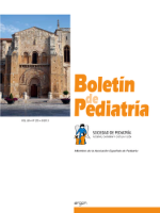Hepatitis por citomegalovirus. Importancia del momento de contagio
A. González Prieto , H. Expósito de Mena , R. Torres Peral , P. González Ildefonso , A. Mateos Diego
Bol. Pediatr. 2013; 53 (225): 164 - 167
Introducción. El citomegalovirus (CMV) es la causa más frecuente de infección congénita en nuestro medio, así como de morbimortalidad perinatal. Caso clínico. Lactante de 55 días que ingresa por ictericia de una semana de evolución, sin acolia ni coluria. Sin procesos infecciosos intercurrentes. Como antecedentes, procede de un embarazo gemelar de 36 semanas con bajo peso al nacimiento. A la exploración destaca coloración pálido-ictérica de piel, con esplenomegalia de 3-5 cm, de consistencia media, sin hepatomegalia. En las pruebas complementarias se objetiva una hepatitis colestásica con serologías positivas para citomegalovirus (IgM). Tras descartar la atresia de vías biliares y confirmar la etiología infecciosa, mediante PCR en plasma y orina, se inicia tratamiento con Ganciclovir intravenoso. Se recupera sangre desecada de las pruebas metabólicas para identificar el origen congénito o adquirido de la infección. Ante la buena evolución de la paciente y la negatividad de la PCR en sangre desecada, se retira el tratamiento 6 semanas después del inicio. Como efecto secundario a la medicación, se objetiva leucopenia leve que responde adecuadamente al tratamiento. Conclusiones. Ante una infección por citomegalovirus, es fundamental identificar el momento de contagio, de cara a establecer el pronóstico a largo plazo. Se sabe que el mayor riesgo de secuelas se asocia con las infecciones congénitas, siendo las que afectan al neurodesarrollo las más frecuentes. A pesar de demostrar el origen infeccioso de la clínica de nuestra paciente, se debe descartar la atresia de vías biliares, dadas las asociaciones existentes entre esta entidad y las infecciones virales.
Cytomegalovirus induced hepatitis. Importance of when the infection is acquired
Introduction.
Cytomegalovirus (CMV) is the most common cause of congenital infection in our media, being responsible of a high rate of perinatal morbility and mortality as well.
Case report.
A fifty-five day old child presented to the hospital with a jaundice noted one week ago. No acolia, coluria or infections were noted at that time. The patient was born at a gestational age of 36 weeks and the weight at birth was below 10 th percentile. The physical exam at admission revealed a pale-icteric skin and 3-5 cm esplenomegaly without hepatomegaly. The laboratory tests showed a cholestatic hepatitis with positive serology for CMV (IgM). After extrahepatic billiary atresia was ruled out and the PCR for CMV, in urine and serum, confirmed the infectious etiology, we started the treatment with intravenous Ganciclovir. The dried blood of metabolic tests was recovered in order to identify the congenital or acquired origin of the infection. Due to the clinical response and the negative result of the dried blood CMV PCR, we finished the treatment 6 weeks later. As side effect, we observed a mild leukopenia which had a good response to the treatment.
Conclusions.
In CMV infection is essential to identify the transmission´s time in order to establish the long-term prognosis. It is well known that the higher risk to develop sequels is joined to congenital infections;. being those that affect neurodevelopment the most frequent. Despite the infectious origin of our patient´s symptoms, extrahepatic biliary atresia must be ruled out because of the association with viral infections.
Artículo completo (PDF) (73 kb.)
- Infectología
